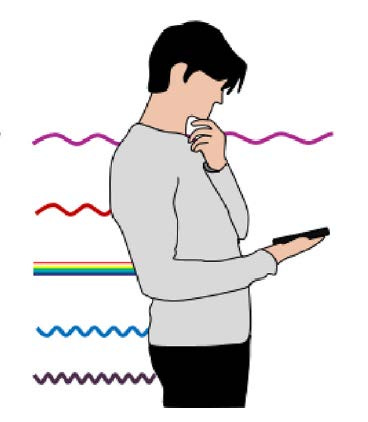Beaming Radio into the Nose
Seoul music at 2.45 GHz
Image from Bok, et al., 2025.
With the exception of surgical removal of airflow-blocking nasal polyps, little can be done to restore smell loss. Olfactory training—the deliberate, repeated sniffing of multiple odors—is the only therapy backed up with clinical evidence: it can help speed recovery from viral-induced loss.
Could there be other, more effective ways to activate the sensory nerves?
A research team in Korea claims to have found one and it’s a doozy: radio frequency (RF) stimulation of the nose.
Bok, et al. generated 2.45 GHz radio waves with a PCB patch antenna. (These are the transmit/receive devices used in smartphones and WiFi routers.) The two inch square circuit board antenna was attached to a headband and positioned about four inches in front of the test subject’s face—it was aimed right between the eyebrows, i.e., at the upper reaches of the nasal cavity where the sensory nerve endings are found.
Smell sensitivity was measured with a Korean version of the Sniffin’ Sticks odor threshold test, in which the participant sniffs pens containing different concentrations of n-butanol. In one version of the experiment, smell function was measured after 5 minutes of RF stimulation at either 5W, 10W, 15W, or 20W of power. In another version, smell function was measured after 1min, 5 min, or 10 min of RF stimulation at 15W.
The results in a nutshell:
First, exposure to 10W or more of RF stimulation significantly increased odor threshold performance from average to near-perfect levels.1 Second, RF exposure at 15W power for 1 min significantly increased odor threshold performance; performance maxed out at exposure times of 5 and 10 min. Third, enhanced odor sensitivity persisted for 4 days following RF stimulation.
These findings are remarkable. In fact, they are so remarkable—so clearcut—that one wonders whether the test procedures were adequately controlled.
For example, participants were supposedly “blind” to whether or not a particular test session involved RF stimulation. RF radiation warms the tissue it’s directed at; clearly this could cue a participant that RF was active. The authors were aware of this and measured minute-by-minute skin temperature on the foreheads of five tests subjects during 15W stimulation. There was a minimal increase in skin temperature across 5 min of RF which the authors take as evidence that participants did not know whether the RF was on or off. Maybe. Or maybe the RF stimulation produced a perceptible warming of the forehead which Bok, et al. simply failed to ask about. Nor did they inquire about perceptible warming inside the nasal passages.
The experimental trials were not run double blind: the person administering the odor threshold test knew whether the trial was RF-on or RF-off, and most likely the duration and power of the stimulation. This raises the possibility of bias from subtle “demand cues.”
To their credit, the authors address this in a supplementary figure which compares the odor threshold scores of 10 people in a “baseline” condition and a “sham stimulation” condition. They find no statistical difference. But what do they mean by baseline and sham? Were the subjects wearing the PCB antenna in each condition? How convincing was the sham? Were baseline and sham conditions counter balanced? And again, the test administrator for these trials was not blind.
Bok et al. may well have solid answers to these questions. I don’t know. If the RF stimulation has the big and lasting effect on odor threshold that they claim, it should be easy to replicate this study under more tightly controlled conditions.
Stay tuned!
Junsoo Bok, Eun-Seong Kim, Juchan Ha, Dong-Min Lee, Bum Ju Ahn, Sang Won Lee, Seok Hyun Cho, Nam-Young Kim and Yongwoo Jang, Non-contact radiofrequency stimulation to the olfactory nerve of human subjects. APL Bioengineering 9:036112, 2025.
There is some confusion here, as the text descriptions and relevant caption in Fig. 4 are at odds with the significance levels as indicated graphically on the figure.


